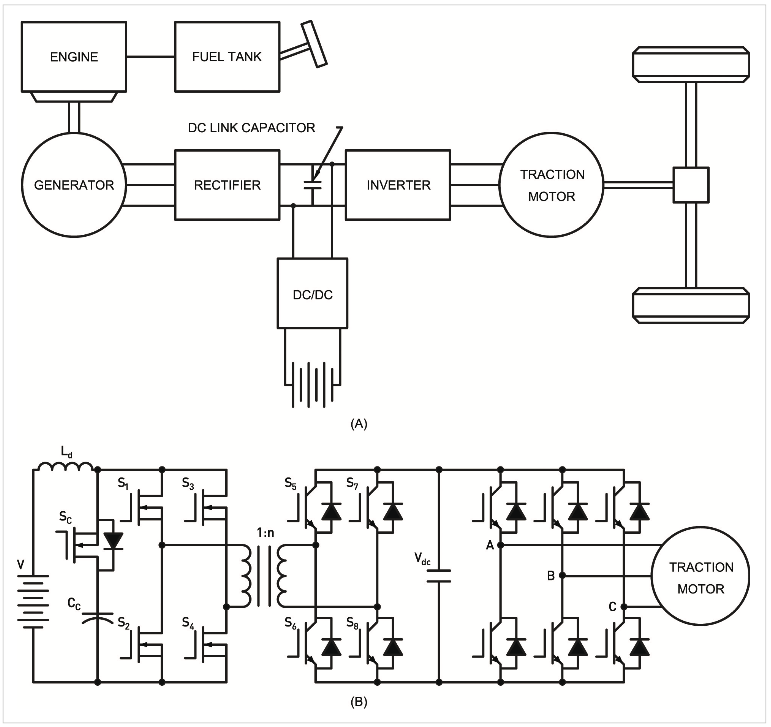

The DC Link Capacitor is a part of power electronics found in inverters, converters, and motor drives. Although its primary function is to smooth out and steady direct current (DC) voltage, it also identifies any sudden jumps in voltage in the DC link circuit. As a result, this capacitor is similar to a steady bridge between the input (beginning) and output (end) of power electronic converters. In electric vehicles, the DC link capacitor protects the inverter circuit by absorbing sudden voltage increases.
The DC link capacitor is made to be strong and capable of holding a signification amount of energy. Given the ability to handle large changes in voltage and temperature, picking the right DC link capacitor is very important for the best performance and life of a system.
In power conversion, when AC is converted to low voltage DC, or AC from one frequency to another, the AC is usually rectified and smoothed. Once this is accomplished, the power is then routed to an inverter to obtain the final output. The DC that is fed into the inverter is called the DC link. As the name implies, the two sources are linked together with a filter capacitor [see Figure 1: DC Link Circuit].
In electric vehicle applications, the DC link capacitor is used as a load-balancing energy storage device. The DC link capacitor is placed between the DC (in this case, the battery) and the AC (which is the load side) of the voltage inverter. The capacitor is placed parallel to the battery, which maintains a solid voltage across the inverter. The device helps protect the inverter network from momentary voltage spikes, surges and EMI. The noise is the result of the pulsed inverter current and stray inductance on the DC bus [see Figure 2: Typical Electric Vehicle Circuit].
The selection of the proper DC link capacitor is important to achieve the proper performance of the system. For example, an under-designed DC link capacitor can cause a premature failure, or will cause EMI interference resulting in problems with other electronic circuitry. An over-designed DC link capacitor is not as cost- or size-efficient.
An electrolytic capacitor is polarized – with a positive and negative terminal similar to a battery – and is filled either with a chemical or solid polymer electrolyte, which gives the characteristic of achieving extremely large capacitance values. The major drawbacks to an electrolytic capacitor are that it has a limited life, the Equivalent Series Resistance (ESR) is extremely large, the leakage current is high, the insulation resistance is low, and the tolerances are broad. The primary advantage of an electrolytic capacitor is large capacity in a small package size at a relatively low cost. A major consideration in selecting an electrolytic capacitor is the temperature range of the device. Remember, even though the capacitor operates at room temperature, the device will increase in temperature rapidly with the voltages and high frequencies present. Electrolytic capacitors should have high ripple and pulse current ratings.


Film capacitors are the focus of this technical bulletin since they have the best performance and reliability. There are two styles of film capacitors: film and foil, as well as metallized film capacitors.
Electrodes in film and foil capacitors are separate sheets of metal foil wound with sheets of dielectric material [see Figure 3: Capacitor Construction]. These electrode sheets (or foils) extend alternately out each end of the capacitor roll beyond the dielectric, which provide a large mass of metal material to which the leads are attached [see Figure 4: Film and Foil Capacitors].
Metallized film capacitors greatly reduce the physical size of the capacitor. Discrete foil sheets are replaced with the thin layer of 99% pure aluminum or other metals that are vapor-deposited directly upon the dielectric material. Since the dielectric material is present at each end of the capacitor along with the metal electrode material, direct attachment of the leads is not possible [see Figure 5: Metallized Capacitors].
The end-terminations of the metallized film capacitors are created by the application of a fine, molten-metal spray. The spray makes contact with the layers of metal electrode resulting in plate contact. As the metal spray particles stack up against the metal electrodes, there is a compression bond resulting in a resistance higher than the discrete metal foils. The leads are attached to this metal spray, which adds additional resistance. Given this, the film and foil construction would be the best selection for a DC link capacitor. However, this style is not usually the best choice due to the size and weight.




Film capacitor selection is extremely important to achieve the best voltage and current-carrying capability for DC link capacitors. The capacitor manufacturer can utilize various combinations of dielectric materials and terminations in the construction of each type of capacitor. That is why it is important for the designer to consider the following:
Partner directly with the manufacturer to achieve the desired final design. Electrocube has a variety of film and electrolytic capacitors – including the 958A series – designed specifically for DC link applications which require long life under extreme operating conditions. Perfect candidates for the 958A series include EV power conversion, aircraft power systems, battery chargers and other high pulse circuit applications. Custom designs are also available.
Selecting the right DC link capacitor is more than a technical necessity, it's a step towards optimizing performance and durability in power electronics.
Our team of engineers is ready to assist you in choosing the perfect DC link capacitor that meets your specific needs, ensuring your systems run smoother, longer, and more reliably.